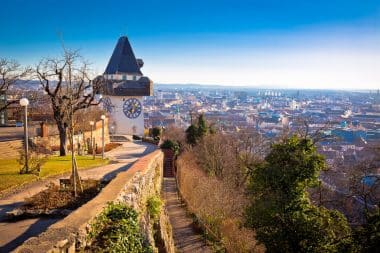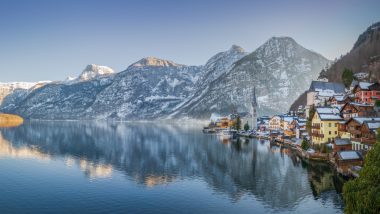Whether it’s a view that stretches for miles on the summit of the Dachstein, an excellent bottle of Welschriesling in the middle of vines, or a visit to the Landezeughaus in Graz – Styria in the heart of Austria has a lot to offer and shines with its diversity.
The cultural-historical capital of Graz

The state capital Graz covers an area of 127.6 km2, with a population of about 440,000 inhabitants. The landmark of Graz is the so-called clock tower on the Schlossberg, in the middle of the city. The Clock Tower is a 34 m high, octagonal shaped bell tower that towers over the entire city. The small “mountain” in the middle of Graz is wonderful for walks, but you can also reach it by the 115-year-old Schlossberg cable car or a lift.
A highlight since 2019 is the landslide, which reaches from the top of the Schlossberg to the streets of Graz and overcomes a height of over 100 m. Graz offers a lot of cultural and historical sights and the old town is a World Heritage Site. In addition to the State Armoury, where you can find armour and weapons from the last centuries, there are also Turkish monuments, a beautiful cathedral, and the city’s famous art house. The Kunsthaus is also affectionately called the “Blue Bubble” because its futuristic appearance resembles that of a blue, alien bubble and is illuminated in the evening.
The Dachstein – the highest mountain in Styria
At 2995 m above sea level, the Dachstein is the highest mountain in Styria. It is located in the west of the province and Styria shares the summit with the neighboring province of Upper Austria. The Dachstein has two peaks, the “Hoher Dachstein”, with an altitude of 2995 m, and the “Niederer Dachstein”, 400 m away, with an altitude of 2934 m above sea level. The “Niedere Dachstein” lies entirely in Upper Austria, while the Hohe Dachstein still belongs to Styria.
The Dachstein is the second highest peak in the Northern Alps and has several glaciers, but they are slowly melting due to climate change. The mountain offers a paradise for mountaineers and skiers. A special feature is the free-hanging “Sky-Walk”, as well as the four-ton boulder from the Chinese province of Sichuan, which the artist Ai Weiwei had transported up the mountain in the course of the cultural festival “regionale x”. The national anthem of Styria, the “Dachstein anthem” is also named after the mountain. Near the Dachstein is the well-known ski flying hill “Kulm”.
The Benedictine Abbey of Admont

In the market town of Admont lies the world-famous Benedictine Abbey of St. Blasius zu Admont. Archbishop Gebhard of Salzburg founded the monastery in 1704 and thus it is the oldest monastery in the whole of Styria. The monastery is located at the entrance to the Gesäuse National Park in Upper Styria. The Gesäuse is a nature reserve and offers a variety of hiking trails, mountaineering routes and ski resorts.
A highlight of the monastery is the famous monastery library, which is known as the largest monastery library in the world. It is 70 m long, 14 m wide, 13 m high and contains a repertoire of about 70,000 books. It is beautifully designed and has special features such as hidden doors. The architect was Josef Huber. The monastery also has a large museum, as well as a beautiful, spacious monastery complex with many gardens.
The Eisenerzer Erzberg
Since the 11th century, iron ore has been mined in the Eisenerzer Erzberg, a mountain in the middle of the Eisenerz Alps. Located in the town of Eisenerz, the mountain mainly provides siderite, and the mining of the ore is the largest iron ore mining in Central Europe. Once a year, the Erzberg is the venue for the “ErzbergRodeo”, the toughest enduro race in the world. The event lasts four days. The annual Erzberglauf is also a popular event, where up to 1000 participants compete in endurance sports. In addition, the Erzberg offers tours for everyone, where you can take a closer look at parts of the tunnels and the mining. On this journey of discovery, a train travels across parts of the mountain, sometimes through complete darkness, and a guide shows various mining sites, underground features and describes the characteristics of the Eisenerzer Erzberg.
Southeast Styria wine region
The area of southeastern Styria is known worldwide for high-quality wine and beautiful landscapes. From Leibnitz, via Gamlitz, to the border with Slovenia stretches a wide, relatively flat hilly landscape, marked by countless vines and a rural ambience. There are heaps of wine taverns and wine taverns where you can eat the typical Styrian “Brettl-Jaus ‘n”. This Austrian “dish” is a colorful bread meal made of smoked and smoked meat, fresh ham and cheese, as well as various spreads. Homemade farmhouse bread is served and wine or natural juice is drunk. Buschenschanken are a popular destination for couples, friends and families. Most of the taverns have their own winery and excellent wine. Desserts, such as typical Styrian Buchteln, filled with jam or nuts, as well as strudel or cakes are also offered.
Southern Styria is a wonderful place to go for a walk and especially in autumn, when the leaves change colour, Southeast Styria is a dreamlike, enchanting landscape. The forests look like they came out of a painting and are definitely worth a visit.


